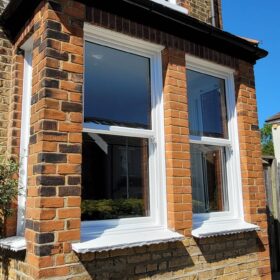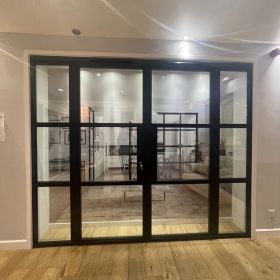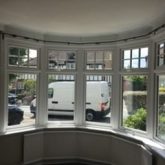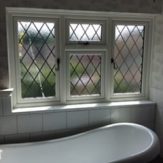Homeowners looking to open up their living space, add value and improve the quality of their properties are often torn between bi-fold and sliding doors – and there may be an easy solution if you have a preference in terms of style!
These modern glazing solutions are popular ways to bring a contemporary, spacious feel, but it’s worth understanding all the pros and cons before you make any decisions.
The Differences Between Bi-Fold and Sliding Doors
The first thing to note is that these wide-pane glazing options work differently, with a range of strengths and weaknesses to bear in mind.
Bi-Fold Doors
Bi-fold doors can open flush with the wall, leaving a completely clear space that connects the outdoors with the inside of your property seamlessly.
You can incorporate an access door if you wish, so you don’t need to slide the doors back all the way if you’d like to nip in and out of the garden.
The doors run on a track at the top and bottom of the frame, with each panel connected to the next by a set of hinges.
Sliding Doors
A sliding door comprises two or more broad glass panels, which slide behind each other, moving to one side of the opening.
The contrast to a bi-fold door is that the space isn’t 100% clear since one door panel needs to slide behind the next, so you will always have at least one static pane of glass.
However, the advantage is that a sliding door system needs minimal room to open – it isn’t operated on a concertina like a bi-fold door, so it is suitable for tight spaces.
Pros and Cons of Bi-Fold Doors
As we’ve mentioned, the primary benefit of bi-fold doors is that the glazing can be fully opened, so you get a maximised space, optimal airflow and as much natural light as hits your property.
Traffic doors are a handy design option, so you can go to and from your garden without needing to open the bi-fold doors on a rainy day.
Other positive aspects of a bi-fold door include:
- Low threshold design options – these are ideal if you need to avoid a high step or need an even entranceway from your garden.
- Customisable design – bi-fold doors can work in large or small openings and have multiple configuration options to match your style preferences.
- Bi-fold doors can open inwards or outwards, depending on where you have the most space to accommodate the folding edges of the panels.
- The aluminium frames are lightweight yet robust and will often increase the market value of your home.
The only drawbacks of a bi-fold door are that it needs some element of storage space, either inside or out, where the folded panels will be stacked against the wall.
If you wish to have an uninterrupted view, you may also want to design a bi-fold door with fewer frames to avoid disrupting the sightline with multiple frames between each glass pane.
Pros and Cons of Sliding Doors
Sliding doors overcome the space challenge if you have no extra room inside your property or in the garden to accommodate the folded window panels.
Because one pane slides behind the next, you will always have some of the entranceway blocked with a static panel, but the space requirements are small since the window doesn’t jut out on either side.
Professional quality sliding doors are also constructed with durable yet lightweight aluminium, so the doors are easy to move, and you get an unobstructed view through the large, clear glass panes.
The potential pitfalls of choosing a sliding door are:
- Reduced access convenience compared to a bi-fold door with a traffic door fitted.
- It may be more expensive than a bi-fold door depending on your chosen system.
- It is impossible to build a track that is flush with your floor, although you can have this sunk at floor level to avoid a steep step up.
Of course, these pros and cons are all relative, and both bi-fold and sliding doors can look stunning – but it’s important to be equipped with all the positive and negative factors that might influence your decision!
Factors to Consider When Choosing Between Bi-Fold and Sliding Doors
Correctly installed, a new set of wide-pane windows can greatly benefit your living standards, with thermally efficient glazing, a sleek appearance, and space saving when contrasted with conventional external doors.
We’ve run through each factor we’d recommend you think about so you have a little more information about the variables at play.
Cost
Bi-fold and sliding doors of the same configuration and with the same type of glazing cost a relatively similar amount – but if you have a very wide opening or require expansive glass panels, you may find that sliding doors become prohibitively expensive.
That is because the larger sliding panels (rather than several smaller panes folding into a concertina) are more difficult to source and can be extremely costly.
If you’re unsure of the cost comparison, please get in touch with Bi-Fold Doors UK, and we’ll be happy to provide some indicative cost estimates.
Energy Efficiency
Glass is thermally efficient, and of all the components within either a sliding or bi-fold door, it is the aluminium frame that is the least insulating.
Sliding doors deliver a marginally higher energy saving because they have less aluminium framing and often have thicker glass that retains warmth.
The caveat here is that we can customise your bi-fold or sliding doors and offer a broad range of energy-conservation treatments or films, so you can improve the U-value to ensure your new doors are as efficient as possible.
Ease of Use
Either type of door is lightweight and uses advanced materials so that anybody can slide or fold the door.
Materials such as aluminium are the most popular since the frame is tougher than UPVC. Still, you can also consider alternatives such as timber that aren’t as easy to manoeuvre.
Appearance
When it comes to your property’s style and aesthetic, it’s very much a question of personal choice!
A bi-fold or sliding door will flood your space with natural light, and while a bi-fold door offers a much wider opening, it also features more vertical frames breaking up the glass.
Sliding doors have a larger proportion of glass and deliver a panoramic view.
Accessibility
We’ve talked about low-threshold steps since this is a crucial factor for many families and homeowners who wish to upgrade their glazing but want an entranceway that is level and accessible by wheelchairs, small children, pushchairs, and those with restricted mobility.
Bi-fold doors can be fitted flush to the ground level with your patio or garden.
If you opt for a sliding door, you can request a low-threshold design, but this is usually at least 12 mm tall as the lowest height aluminium strip.
An alternative is to sink the sliding door mechanism into the floor, although this may become more expensive depending on the work required.
Bi-Fold Doors vs Sliding Doors – Which Is Best?
There is no universal right answer because it’s entirely up to you which benefits sway your decision or which drawbacks form a deal breaker!
We hope this like-for-like comparison has given you a great idea about the pros and cons of a sliding or bi-fold door and has made it easier to pick the glazing best suited to your home, family and requirements.





